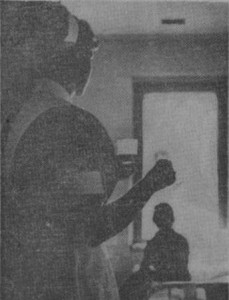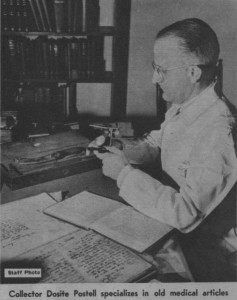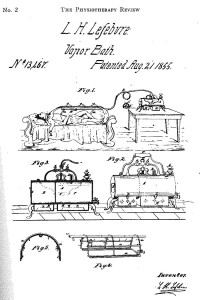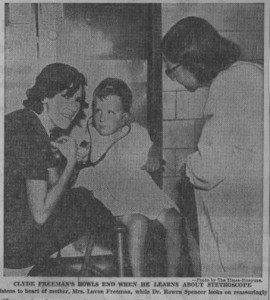Match Day 2013
Congrats to all the Medical Students who matched on Friday. Glad to hear that over 100 of you will be sticking around.
Check out a few local news stories: from Fox8 and NOLA.com and the Advocate.
Congrats to all the Medical Students who matched on Friday. Glad to hear that over 100 of you will be sticking around.
Check out a few local news stories: from Fox8 and NOLA.com and the Advocate.
LSUHSC is hosting a free study for adults with well-controlled asthma as part of the American Lung AssociationÔÇÖs Long-acting Beta Agonist Step-Down Study (LASST). People 18 years of age and older who have controlled asthma are encouraged to call 504-568-3450 for more information.
With the high cost of medicine, patients have been known to lower their own dosages as their health improves in order to save money. LASST seeks to study various treatment plans as a way to safely decrease dosages of asthma medication over time. Below is the description of LASST as presented on the American Lung Association website:
ÔÇ£Current asthma guidelines recommend stepping down therapy once asthma is controlled for at least three months. For patients treated with inhaled corticosteroids (ICS) alone, a dose reduction of 25ÔÇô50 percent to a minimal dose that controls disease is established. However, the optimal approach to reducing treatment in patients with asthma that is well controlled on fixed dose combination ICS/LABA (long-acting beta agonists) is not clear. The study will compare three approaches of care to patients with asthma well controlled for three months on combination ICS/LABA therapy: reduction of ICS dose and maintenance of LABA, initial discontinuation of LABA with continuation of ICS and continuation of stable dose ICS/LABA. The data will allow the determination of?áthe optimal treatment strategy?ádefined as that which results in the lowest rate of treatment failure over 48 weeks of follow up. Additional exploratory analyses will include assessing risk factors for step-down failure and assessing the optimal duration of time that asthma control should be maintained before therapy is reduced.ÔÇØ
The Centers for Disease Control have released?á2013 Vaccine Recommendations for adults. Changes include new recommendations for Pneumococcal Vaccine and Tdap/ Td Vaccines.?á There is also a simple quiz to help patients figure out what vaccines may be necessary. For more complete information, see the complete report, Advisory Committee on Immunization Practices (ACIP) Recommended Immunization Schedule for Adults Aged 19 Years and Older ÔÇö United States, 2013.
In America, methods of care for our mentally ill have become intertwined with the politics of universal healthcare, hospital administration, and prevention of violent crime, all of which suffer under an increasingly budget-cut government. This issue is not a new one, however. The Newspaper Clippings Digital Collection of the Isch?® Library shows an emerging pattern: a pattern of need. Hospitals and treatment centers need enough beds for psychiatric patients; hospitals need staff to treat those patients; police officers, clergy, and even the general public need training to assess and assist the mentally ill.
Linkages of mental illness and criminal tendencies also surface. In recent news, LSU psychiatrist Dr. Jose Calderon-Abbo joined the vice presidentÔÇÖs task force on gun violence; he has also partnered up with Tulane public health criminology expert Dr. Peter Scarf to present a paper of similar topic to the House Subcommittee on Crime, terrorism, and Homeland Security at a hearing on The Youth Promise act.
Not only do mental illness and crime sometimes occur simultaneously, but those charged with apprehending the mentally ill are often the same people who apprehend criminals.?á One of our newspaper clippings from 1961, entitled ÔÇ£How Police Can Help Mentally Ill,ÔÇØ addresses the need for officers of the law to be properly trained on how to interact with, assess urgency of treatment for, and detain suspects who appear to be suffering from illness, loss of competency, or loss of sanity.
The clergy are often called upon to assist the mentally ill; one article, ÔÇ£Help of Clergy Asked by Many: Role of Churchmen for Mentally Ill Cited,ÔÇØ explains how the clergy ought to be well versed in tactics to understand and aid their congregations. Examples of tactics used to interact with those in need in the include: a manual from 1954 ÔÇ£How to Recognize and Handle Abnormal PeopleÔÇØ by Robert A. Matthews and Loyd W. Rowland, former director of the Louisiana Association for mental health and former Head of the department of psychiatry and neurology, ?áin addition to a 1960 New Orleans officer training film, ÔÇ£Booked for Safekeeping,ÔÇØ produced by George C. Stoney.
In 1961, the name of the game was “expedite”: complex legislature  required the approval of a hospital director, an order of commitment signed by the coroner, a psychiatrist, and a responsible party, and approval from a civil judge. Convoluted commitment laws and lack of funding for psychiatric facilities and staff were concerns at this time, but these concerns continue today as the Greater New Orleans area loses beds at Charity Hospital and MandevilleÔÇÖs Southeast Louisiana Hospital.
required the approval of a hospital director, an order of commitment signed by the coroner, a psychiatrist, and a responsible party, and approval from a civil judge. Convoluted commitment laws and lack of funding for psychiatric facilities and staff were concerns at this time, but these concerns continue today as the Greater New Orleans area loses beds at Charity Hospital and MandevilleÔÇÖs Southeast Louisiana Hospital.
In the words of Dr. Robert A. Matthews, former head of the department of neuropsychiatry at LSUHSC from 1950-1957, ÔÇ£While we are passing the hat around for money to fight polio, heart disease, cancer, tuberculosis and other maladies, we ought also to be financing some exploration in to the cause and cure of emotional storms and mental defectiveness. We are fast becoming a nation of neurotic people.ÔÇØ
Glimpse of the Past is an ongoing project to promote the Louisiana Digital Library effort. This Month in History will present for your reading pleasure a closer look into a newspaper clipping of note from our Digital Collections and articles relating to the LSU Medical School.
Dr. Cooper, a one-time anatomy Professor at the LSU Medical School, was also well-renowned for his poetry.?á Recognized for his ÔÇ£consistently good work in poetryÔÇØ by a forum of the National Writers Club in 1951 and awarded the position of Louisiana Poet Laureate from 1973-1976, Dr. Cooper is a?ácommon subject of our Newspaper Clippings Digital Collection. Though the Isch?® Library does not own any of his poetry collections, they are available through InterLibrary Loan.
Excerpted below?á is a poem from one of?áhis collections dedicated to a previous ÔÇ£Glimpse of the PastÔÇØ honoree, Dr. Frank N. Low. I would like to?áshare this poem with our new and returning students, who will surely feel the ÔÇ£grindÔÇØ immediately upon returning to classes:
The LSUHSC Libraries support Dynamed, a point of care database that provides the best available evidence to support clinical decision-making.?á DynaMed is?áa comparable product to UpToDate and much more affordable.
While the?áLSUHSC New Orleans Libraries were never involved in the UpToDate subscription and had no access, we are hearing that it is no longer available from various hospital websites. We suggest you try DynaMed as the alternative.
Would you trust a medicine that’s been under water for a couple of millennia??áAn early edition article (and a link straight to the PDF) in Proceedings of the National Academy of Sciences analyzes tablets found in a sealed container that was part of the material recovered from the a wreck in the Mediterranean sea off the coast of Tuscany in Italy. The abstract for the article states, “The composition and the form of the Pozzino tablets seem to indicate that they were used for ophthalmic purposes.”
The article is certainly generating a lot of press, from Wired to the Smithsonian to the BBC?áto the Washington Post.
Link to the pdf of the article is available to LSUHSC faculty, staff & students. It can be accessed off-campus with a valid LSUHSC library barcode & PIN. You can find more information at our remote access webpage.
Last week, MedlinePlus, the National Library of Medicine and National Institute of Health’s consumer health database, published the top 10 most?ávisited health topic searches?áof 2012:
Looking at these searches, it would seem that the public are?ásearching for information on?áthe most common health?áthreats in the?áUnited States.?á?áAccording to the Mayo Clinic, the top seven threats to women’s health are?áheart disease, cancer, stroke, chronic lower respiratory diseases, Alzheimer’s disease, accidents, and type 2 diabetes. The top seven threats to men’s health are similar:?áheart disease, cancer, accidents, chronic lower respiratory diseases, stroke, type 2 diabetes, and suicide.
Of course the most visited sites could also mean that people who were diagnosed with high blood pressure and diabetes started exercising?ábut they had trouble breathing, had heart palpitations,?ágot sunburned, and hurt their backs!
 Do you ever drink water from the opposite side of the glass to cure hiccups or apply duct tape to a wart or spray Windex on a zit? These are just a few examples of therapeutic home remedies, but where do they originate? A collector of ÔÇ£weird-lookingÔÇØ medicinal gadgets and medical historian, Mr. William Dosite Postell, is the star of our highlighted article this month.
Do you ever drink water from the opposite side of the glass to cure hiccups or apply duct tape to a wart or spray Windex on a zit? These are just a few examples of therapeutic home remedies, but where do they originate? A collector of ÔÇ£weird-lookingÔÇØ medicinal gadgets and medical historian, Mr. William Dosite Postell, is the star of our highlighted article this month.
Former Librarian of the LSU Medical School, Mr. Postell was a Will of all trades: as he believed, ÔÇ£There is a little bit of the clinician, the research worker, the medical historian, the medical philosopher, the bibliophile, as well as the custodian and the library technician, in each successful librarian.ÔÇØ Though his career at LSUMS was principally one of librarianship, Postell was able to branch out from that role, becoming a scholar of wacky medical wares like cholera baths and mad dag stones.
 One outdated cure is the ÔÇ£vapor bath,ÔÇØ invention of a Louisianan, Dr. Louis H. Lefebrve. Depicted in the drawing here, Postell found an early bath in the possession of the Prudhomme family of Natchitoches, Louisiana on one of his excursions to area antebellum plantations. The bath utilized sulphuric acid to assuage the effects of cholera. The story of the madstones or ÔÇ£bezoarsÔÇØ comes from the frontier. These stony hairball-like concretions were taken from the stomachs of deer, cows, or goats and placed on a bleeding wound to draw out poisons like those from the rabies virus or snake venom. In modern medicinal practice, the bezoar is considered a serious health risk in gastrointestinal tracts of humans and has lost its curative mythos (unless, of course, you live in the Wizarding World of Harry Potter, where the bezoar cure is alive and well).
One outdated cure is the ÔÇ£vapor bath,ÔÇØ invention of a Louisianan, Dr. Louis H. Lefebrve. Depicted in the drawing here, Postell found an early bath in the possession of the Prudhomme family of Natchitoches, Louisiana on one of his excursions to area antebellum plantations. The bath utilized sulphuric acid to assuage the effects of cholera. The story of the madstones or ÔÇ£bezoarsÔÇØ comes from the frontier. These stony hairball-like concretions were taken from the stomachs of deer, cows, or goats and placed on a bleeding wound to draw out poisons like those from the rabies virus or snake venom. In modern medicinal practice, the bezoar is considered a serious health risk in gastrointestinal tracts of humans and has lost its curative mythos (unless, of course, you live in the Wizarding World of Harry Potter, where the bezoar cure is alive and well).
Postell was quite the adventurous and successful librarian no stranger to going above and beyond his position in pursuit of knowledge. Having served as President of the Medical Library Association (MLA) in 1952 and 1959, he was awarded the prestigious Marcia C. Noyes award for his outstanding contributions to medical librarianship. In a memorable article of the Bulletin of the MLA, Postell wrote, ÔÇ£The best publicity a library can secure is by way of service given. The circulation and reference desk is the best place at which good will can best be cultivated. It is here that the public is met and served. It is the here that new patrons obtain their first impression of the library. If they are met graciously and served competently, they will return.ÔÇØ
Stop by the Isch?® Library sometime and let us graciously and competently show you the wonderful resources at your fingertips! If you are interested in reading PostellÔÇÖs work, the LibraryÔÇÖs holdings include: Applied Medical Bibliography for Students, The Development of Medical Literature, and The Health of Slaves on Southern Plantations.
Glimpse of the Past is an ongoing project to promote the Louisiana Digital Library effort. This Month in History will present for your reading pleasure a closer look into a newspaper clipping of note from our Digital Collections and articles relating to the LSU Medical School.
Any free time during the holidays? Well you might want to take advantage the Basic Life Support for Healthcare Providers course. You will learn CPR techniques to assist people of all ages and how to use an AED. Cost is $50 and itÔÇÖll only take approximately 4hours.
For more info, check out the flyer:?á
PIG (Pediatric Interest Group) is sponsoring a toy drive.?á Drop off boxes are in Lecture Halls A & B on the 1st floor of the MEB. Last day to donate is Tuesday December 18th, so hurry!
Making the internet rounds is this story, of a Tucson Mom who had been leaking cerebral spinal fluid for four months before it was caught. Endoscopic surgery at the University of Arizona repaired the cracks in her sphenoid sinus and stopped the gushing.
This January, the LSU Health Sciences Center jumps on the health education bandwagon as it inaugurates a brand-new ARC-PA accredited physician assistant training program. LSUHSCÔÇÖs 29-month program of study in evidence-based medicine will instruct its students in patient examination, diagnosis, and treatment.
Dr. Charles L. Hudson first proposed the creation of a physicianÔÇÖs assistant position at a 1961 meeting of the American Medical Association (AMA) as a way to mitigate the decline in primary care providers. Ranked second in CNN Money MagazineÔÇÖs ÔÇ£Best Jobs in America 2010,ÔÇØ this careerÔÇÖs ÔÇ£average annual pay was $86,410 in 2010 according to the U.S. Bureau of Labor Statistics. Federal labor officials projected a 30 percent growth rate in the occupation between 2010 and 2020.ÔÇØ
The John P. Isch?® Library would like to take this opportunity to welcome LSUHSCÔÇÖs 30 new students to the School of Allied Health Professionals! We look forward to introducing you to all our Library has to offer.
The LSUHSC HOP Clinic was featured as a case study in the Ryan White HIV/AIDS Program Progress Report 2012(pgs 32-40). The Report is issued by the US Department of Health and Human Services – Health Resources and Services Administration – HIV/AIDS Programs.?á The many services offered by the Clinic and several faculty members are highlighted.
Despite the resemblance, Dr. Rowena Spencer explains, children are not tiny adults; indeed, ÔÇ£Children are like little chickens. They like to know their way around.ÔÇØ As one of the first women in the country to specialize in pediatric surgery as well as the first woman appointed to the surgical staff at the LSU Medical Center and the first female surgeon in the state of Louisiana, Dr. Spencer proved a wonderful asset to any hospital. Her bedside manner set her apart as a surgeon of unparalleled worth.
Dr. Spencer preferred to take a lighter approach to her smaller patientsÔÇöbeing a friend instead of a threat; as a 1960 Times-Picayune article describes, ÔÇ£She is not above bribing a youthful patient with a nickel or a piece of candy.ÔÇØ And when asked in a recent interview about the most satisfying part of her work, she answered, ÔÇ£Holding the babies. I love babies more that a mule can kick.ÔÇØ
 A forerunner for females in the surgical arena, Dr. Spencer faced some adversity, though she did not appear to dwell on this issue. She persevered to become a respected member of the medical community at a point in history rife with tension over not only the presence of women in the medical field but also African-Americans. At Johns Hopkins University, where she earned her M.D. in 1947, Spencer was in good company. She studied under Dr. Alfred Blalock and his laboratory technician, Vivien Thomas. Thomas, an African-American with little formal education, played an integral role in helping save those suffering from ÔÇ£blue baby syndrome.ÔÇØ Another partner in this discovery was Helen Taussig, founder of the field of pediatric cardiology and first female president of the American Heart Association. The work of Blalock, Thomas, and Taussig on the heart is immortalized in a PBS production, ÔÇ£American Experience: Partners of the HeartÔÇØ(2002), and in a Hollywood production, Something the Lord Made (2004). Dr. Spencer would continue their work on infant patients, making a name for herself as an authority on conjoined twins.
A forerunner for females in the surgical arena, Dr. Spencer faced some adversity, though she did not appear to dwell on this issue. She persevered to become a respected member of the medical community at a point in history rife with tension over not only the presence of women in the medical field but also African-Americans. At Johns Hopkins University, where she earned her M.D. in 1947, Spencer was in good company. She studied under Dr. Alfred Blalock and his laboratory technician, Vivien Thomas. Thomas, an African-American with little formal education, played an integral role in helping save those suffering from ÔÇ£blue baby syndrome.ÔÇØ Another partner in this discovery was Helen Taussig, founder of the field of pediatric cardiology and first female president of the American Heart Association. The work of Blalock, Thomas, and Taussig on the heart is immortalized in a PBS production, ÔÇ£American Experience: Partners of the HeartÔÇØ(2002), and in a Hollywood production, Something the Lord Made (2004). Dr. Spencer would continue their work on infant patients, making a name for herself as an authority on conjoined twins.
Examples of her work include many articles such as: ÔÇ£Parasitic Conjoined Twins: External, Internal, and DetachedÔÇØ and ÔÇ£Congential Heart Defects in Conjoined Twins.ÔÇØ An autographed copy of her text, Conjoined Twins: Developmental Malformations and Clinical Implications, is available for checkout at the Library. Dr. Spencer has also had the honor of being featured in a publication entitled, Louisiana Women: Their Lives and Times. Her chapter, ÔÇ£A Study of Changing Gender Roles in Twentieth-Century Louisiana MedicineÔÇØ by Bambi L. Ray Cochran, appears alongside essays on Marie Therese Coincoin, Oretha Castle Haley, and many others in a fitting tribute to their contributions. Dr. Spencer recently celebrated her 90th birthday.
Glimpse of the Past is an ongoing project to promote the Louisiana Digital Library effort. This Month in History will present for your reading pleasure a closer look into a newspaper clipping of note from our Digital Collections and articles relating to the LSU Medical School.